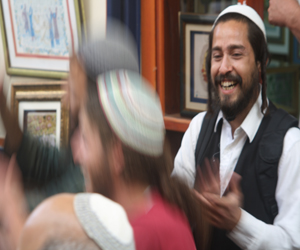Klezmer Style And Form
At the time klezmer bands began to form, the Turks were ruling a large swathe of Eastern and Central Europe. The music of the Turks appealed to the klezmer musicians, who had their musical roots in the Middle East, and so the klezmorim absorbed much of the Turkish style into their own music. Because Jewish religious music has its basis in text, there is a certain arrhythmia to the klezmer style. The Oriental influence is also apparent through the omission of harmonies and unaccompanied long-held notes. Traditional klezmer music is busy with trills, grace notes, rippling scales, and mock weeping sounds.
Klezmorim developed their own terminology to distinguish their musical effects from those of their non-Jewish counterparts. A krekhts (groan) connotes a wailing, weeping sound. The tshok is the instrumental sound of laughter. Another term is the kneytsh, which imitates the sound of a voice catching as it sobs. All of these terms are also used in traditional cantorial music and it's easy to see the parallel between the two music forms.
"Jewish" Music
The Jewish klezmer audiences in 19th and 20th century Europe were treated to tunes specific to particular occasions and rituals. These songs were considered to be "Jewish," even as tunes of the local populaces continued to be absorbed into the repertoire. Bowing to popular demand, klezmer bands began to play waltzes, quadrilles, polonaises, polkas, lancers, kozachoks, and kolomeykes. Certain tunes that were popular with the local non-Jewish populations became so well absorbed into klezmer that these, too, came to be considered "Jewish" music. Some examples of Jewish music with its roots in non-Jewish European music include the serba, hopke, hora, and doina.
Weddings required a long list of tunes and dances to accompany all the Jewish nuptial rituals. Here are some of the more traditional wedding tunes and dances a typical klezmer band might have played in pre-Holocaust Eastern Europe:
Quarreling Parents
Brogez Tantz—This is a traditional dance with a special tune representing the quarreling and reconciliation of the parents (machatunim) of the groom and bride. This might be 32 bars of anger and menace, succeeded by a merry freilechs.
Dobranoc—This is the tune that accompanies the entrance of the guests to the festive wedding meal held in the home of the bride's parents. Important personages were greeted with longer sober tunes while lesser guests were serenaded by shorter tunes. After all the guests had arrived a freilechs was played. Other types of dobranoc were played as the guests departed the feast and as they said their goodbyes to the hosts.
Vorshpiel—This is the tune that was played at the conclusion of the special meal held in honor of the groom on the eve of the wedding.
Happy Tunes
Freilechs—Happy tunes expressing the joy of the occasion.
Fun der Chuppa—The tune played to accompany the couple on their way to or from the wedding canopy. These were sometimes played for guests making their way through the town streets to the wedding, or for festivities held the day prior to the wedding.
Guta Morgen or Es Togt Shoyn—Literally: the day dawns. This tune was played during the very earliest hours of the morning as a not-so-gentle reminder to the guests that it was time for them to go home.
Kalleh Badecken—This was the veiling of the bride. The bride sat in a fancy chair decorated with flowers and the badchan or master of ceremonies would call out verses of warning and encouragement. The klezmorim played musical phrases to complement the declaiming of the verses and the fiddle worked in tandem with the voice of the badchan.

